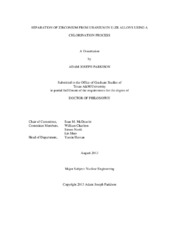| dc.description.abstract | The fundamental behavior underpinning a new processing concept was demonstrated which is capable of separating uranium from zirconium in U-Zr alloys through the formation and selective volatilization of their respective chlorides. Bench-scale chlorination and volatilization experiments were conducted on uranium, zirconium, and a U-50 wt% Zr alloy in order to gather the data needed to develop processing methods and equipment. It is also proposed that the demonstrated chlorination process may be coupled to a hydride/dehydride pulverization process, resulting in increased process efficiencies and simplified equipment design.
Process variables such as temperature, pressure, surface area, and reaction time were studied in an iterative manner until the variables needed for selective volatilization were discovered. This began with the design and assembly of an experimental apparatus which was capable of surviving a hot chlorine atmosphere. It was found that standard glass test-tubes were suitable as reaction vessels for these experiments. Heated and non-heated regions were established within the glass reaction vessels to allow for volatilization and condensation of the volatile chlorides through natural convection. The volatilized and non-volatilized products were collected and analyzed using EPMA to determine the relative uranium and zirconium compositions.
It was found that chlorination reactions on gram-size samples at temperatures of 320, 340, 360 °C generated a uranium product with 89.9, 95.0, and 98.8% purity, and a zirconium product with 82.1, 85.1, and 84.2% purity, respectively. These separations were achieved through a single distillation with a U-50 wt% Zr starting material. It is anticipated that further distillations could be used to achieve increased uranium and zirconium purity, and changes in system geometry could also significantly increase these purities, specifically with the zirconium product stream. | en |


